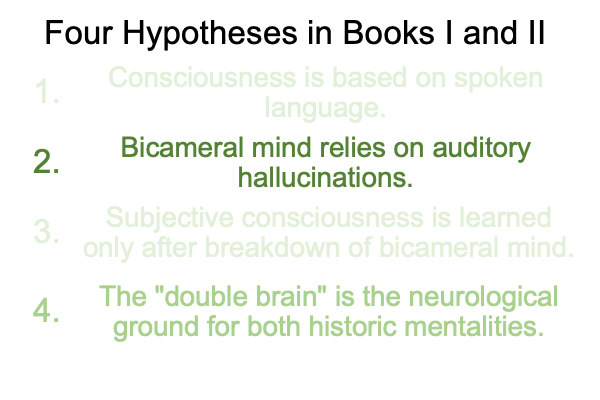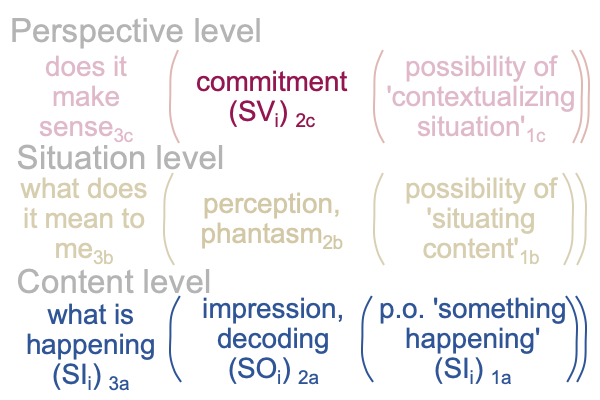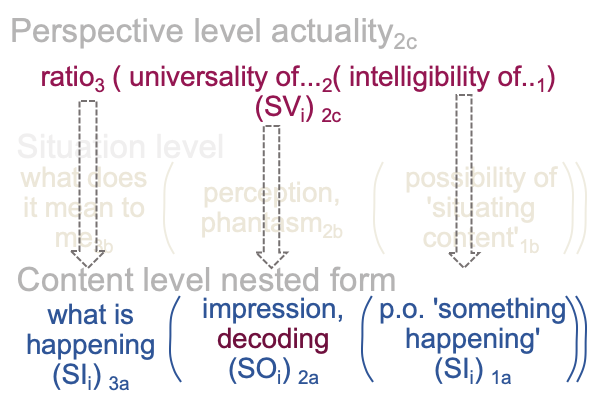0448 But, isn’t the problem of Julian Jaynes’s hypothesis the second item in the following list?

0449 So far, this examination is undecided.
Yes, it is a terminological problem, because the double-brain is also one of the proposals. I know from this examination that the double-brain evolves as a two-chambered cognitive property of the human brain… er… mind. The bicameral mind pumps interventional sign relations.
No, the term, “auditory hallucination”, is a projection of modern sensibilities onto subject matter that… well… may be too disturbing to discuss. What if the casual dismissal of Jaynes’s four-strand thesis could be played back, in the mind of a modern objector, in the voice of a well-regarded psychology professor. You know the one that I am referring to. Just look at all the awards on display in the office. What if…
0450 I pause, while the reader shudders.
…the hallucinated voice of the psychology professor tells the modern objector what to say about the topic of “auditory hallucinations”?
Of course, it is nonsense.
0451 Now, let me walk through my bimodal answer.
0452 My first step is to consider the scholastic interscope for how people think. The interventional sign-relation is embedded within this interscope. This interscope, by the way, belongs to the human niche. This interscope is an actuality that is independent of the adapting species.

0453 On the perspective level, a normal context asking, “Does this make sense?”3c, brings the actuality of the unfolding of judgment2c into relation with the possibility of ‘contextualizing the situation ‘1c. “The situation” includes both phantasm2b (species expressa2b) and impression2a (species impressa2a).
With sensible construction, the perspective-level comes into play only when something goes wrong. Julian Jaynes’s description of the occasion of the auditory hallucinations2c(2a) of the bicameral mind concurs. In the Iliad, visual and auditory hallucinations are (1) taken for granted as real and (2) received under stressful situations.
0454 My designation for Jaynes’s “auditory hallucination”?
I designate the actualities within the interventional sign-relation.
Say what?
Another way to label an auditory hallucination2c(2a) is SVi(SOi).
0455 The SVi of commitment2c can be depicted as a category-based nested form. A ratio (rationes, relation, thirdness) brings the intelligibility of perception (species expressa intelligibilis, what ought to be, firstness) into relation with the universality of sensation (species impressa intelligibilis, what is, secondness).
0456 Since commitment2c (SVi) is a category-based nested form and the content-level of the scholastic interscope (SIiand SOi) is a category-based nested form, one initially anticipates resonances between the two nested forms. These resonances are built into the interventional sign-relation as a human adaptation.

0457 The first resonance is between ratio3(2c) (or balance3(2c)) and what is happening3a.
The implication is that (as far as scholastics are concerned) everything that happens has a reason. A Christian theologian contends that the universe embodies the rationality of God. Modern science presumes that the universe is rational, but avers in regards to the theologian’s contention.
0458 The second resonance is between the universality of sensation2(2c) and sensation(impression(decoding))2a.
In Latin, the second resonance is between species impressa intelligibilis2(2c) and species impressa2a. The plainness of the Latin assists, because each of these terms must be regarded holistically. In English, scientific terminology elaborates further distinctions and wholeness is veiled. For example, for the perspective-level actuality2c, the Latin term, intelligibilis, translates as “universality”. Also, species impressa2a is captured by three distinct terms: sensation, impression and decoding.
0459 What else about the second resonance?
The Christian theologian contends that our senses are true. Our senses are universal. A universal applies to well… just about everything.
To me, this contention comports with sensible construction. Social construction produces impressions that do not necessary entail things that trigger external and internal senses. Rather, social construction wrestles with grammatically correct, counter-intuitive statements that are decoded into literal referents that do not make sense, and demand the construction of a cognitive space that accommodates the statements.
The scientist practices the second resonance with every observation and measurement. If the universality of sensationis not valid, then the observations and the measurements of one researcher should not be reproduced by another researcher. Yet, the reproduction of experimental data by independent researchers is a hallmark of science.
0460 The third resonance is between the potential intelligibility of perception1(2c) and the possibility of ‘something happening’1a. In Latin, the third resonance is between species expressa intelligibilis2(2c) and oops, there is no Latin term for the potential of ‘something happening’1a.
How about itshay appenshay?
But, what about intelligibility?
Firstness exhibits the logic of inclusion. Firstness allows contradictions. So, even if ‘something happening’ is purely random, such as tarot cards in a well-shuffled deck, the cards that are drawn include the potential of an intelligible perception1(2c), according to the third resonance. The task of a card-reader is to weave the lay of the cards2c into a phantasm2b, by decoding each card as a symbol in a symbolic order2a. The cards speak for themselves. The card-reader merely integrates the species impressae2a into a phantasm2b that is intelligible enough to address the client’s questions.
0461 Christian theologians may chuckle at the idea of the third resonance, between the potential intelligibility of perception1(2c) and the possibility of ‘something happening’1a. But, I bet that every day those theologians pray for the insight to recognize the wisdom hidden within the craziness of everyday living.
0462 Scientists use the third resonance in order to appreciate how hypotheses are generated, as opposed to how hypotheses are tested. Of course, every hypothesis must eventually be framed in a manner that allows observations, measurements, and modeling, based on specialized technical terminology. Courses in “what is science” emphasize these aspects, because they increase the reputation that science enjoys.
But, consider any modern scientific theory and imagine how a premodern scholastic could ideate its highly technical formulation. To me, every day, the sun goes around the earth. The continents are not floating on a sea of molten magma. I don’t ever notice when a radioactive element decays. The sun produces blinding light through a mechanism that involves things that nobody can see with their eyes. I can go on, by why bother?
Scientists presume that ‘something happening’1a has the potential to be intelligible1(2c) in ways that we would never even dream.
